Building a Food Safety Culture
By Geoff Schaadt
When we say, “We need to improve our food safety culture,” a number of questions follow this simple statement.
 Questions such as “Why?” Or, “Does this have something to do with our strategy?” Or, “Is that because of the new regulations?” These all matter, but the most important question is, “What do we really mean when we say ‘food safety culture’?”
Questions such as “Why?” Or, “Does this have something to do with our strategy?” Or, “Is that because of the new regulations?” These all matter, but the most important question is, “What do we really mean when we say ‘food safety culture’?”
What Culture Isn’t
Before examining what we mean when we talk about corporate culture, and more specifically food safety culture, let’s first try to understand what corporate culture isn’t. It is not the poster hanging in the lobby that lists “Our Corporate Values.” And it isn’t just the nearby plaques that display the mission and vision statements.
Food safety culture is not part of a policies and procedures manual. Nor is it whatever the HR “onboarding” manual wants new hires to think it is.
What Culture Is
Food safety culture, and other aspects of corporate culture, is “the smell of the place”. It’s the reserved parking and bathrooms and breakrooms. It’s tickets to Game 7 in the corporate suite. It’s all of the things that are discussed in the coffee room.
Culture is all of the things that add together to inform the decisions made at every level of the organization. It is the shared – though often unstated – values and beliefs that cross the boundaries of the company. It is the common understanding of the organization that provides the background and structure that supports the decision-making process for every employee.
It’s ‘how things are done here’.
Why Culture Is Important
The culture of a company is at the very heart of everything that occurs from the executive offices to the plant floor, because it is culture that answers all of the questions with, “Because that’s how we do things here.” Culture is the glue that binds every individual within the organization together within one framework, one accepted way of doing their jobs and interacting with those around them. Culture is one of the most powerful tools that a company has for accomplishing the tasks and goals set before it. It can create alignment and a tremendous sense of shared purpose, and contribute to a corporation’s image and bottom line. Culture, food safety culture, is absolutely critical to all food manufacturing companies.
However, it can just as easily result in a disconnected, disengaged, and cynical workforce. Unfortunately, it is all too common that the message being delivered to the employees is at odds with the daily realities that they face. When this cognitive dissonance becomes a regular feature of life within the organization, cynicism and disengagement are quick to follow.
Where Culture Comes From
Culture almost always emerges from the top of the org chart and filters down. The message is important, and aligning practice with the message is even more so. In the context of a food safety culture, the C-suite must make decisions and exhibit practices that clearly demonstrate a commitment to the quality and safety of the product. When executives make decisions that value the safety and quality of shipped product over revenues, this is the culture that will boost employee morale and commitment, protect the public interest, and the company’s bottom line.
About the Author
Geoff Schaadt, MSc, MBA, is a consultant and practice leader, business sustainability, with Delta Partners Inc. (http://deltapartners.ca), a management consulting firm headquartered in Ottawa, Ontario. For more information on culture and change management, contact Geoff at [email protected].
To have more articles like this emailed to your inbox, become a GFSR Member today!

-
 FeaturedRisk management
The Cost of a Breach: What a Cyberattack Could Mean for Food Safety Recalls
FeaturedRisk management
The Cost of a Breach: What a Cyberattack Could Mean for Food Safety Recalls
-
 FeaturedRisk management
Securing the Food Chain: How ISO/IEC 27001 Strengthens Cybersecurity
FeaturedRisk management
Securing the Food Chain: How ISO/IEC 27001 Strengthens Cybersecurity
-
 FeaturedRisk management
Revolutionizing Food Safety Training: Breaking Out of the “Check-the-Box” Mentality
FeaturedRisk management
Revolutionizing Food Safety Training: Breaking Out of the “Check-the-Box” Mentality
-
 GFSI Standards
GFSI 2025: Building Trust, Tech-Forward Solutions, and Global Unity in Food Safety
GFSI Standards
GFSI 2025: Building Trust, Tech-Forward Solutions, and Global Unity in Food Safety
-
 FeaturedFood Safety
Integrated Pest Management: Strategies to Protect Your Brand’s Reputation
FeaturedFood Safety
Integrated Pest Management: Strategies to Protect Your Brand’s Reputation
-
 FeaturedFood Safety Culture & Training
No Open Door Policy: Challenges That Impact Pest Control in Food Processing Plants
FeaturedFood Safety Culture & Training
No Open Door Policy: Challenges That Impact Pest Control in Food Processing Plants



